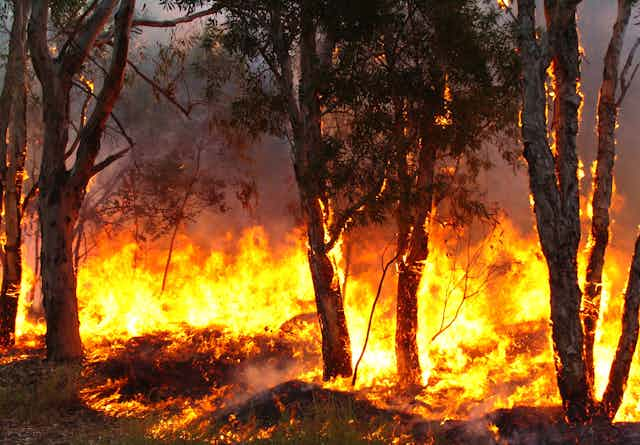Last week Victoria announced a new plan to manage bushfire risk by conducting prescribed burns.
Previously, Victoria had adopted a plan to burn 5% of the state’s area each year to manage bushfire risk. The 5% target has been criticised by scientists for damaging the environment without necessarily reducing risk. But, following a review, the state is shifting to a new “risk-based” strategy.
So, how does the new strategy work and what can we learn from it?
Targets: a blunt instrument
Immediately following the devastating Black Saturday bushfires there were many questions about whether the government could have done more to either prevent such an event or at least reduce the impact of the fires.
A Royal Commission considered a range of submissions from government, the public and scientific committees. Following careful consideration of the information, the commission handed down 67 recommendations. Recommendation 56 was to adopt a long-term program of prescribed burning with a rolling average of 5% per year on public land.
A range of research has since been conducted examining the role of prescribed burning in reducing the risk to people and property (some examples here, here and here), as well as the impact on biodiversity (some examples here, here and here).
The key message is that a hectare target is not the most cost efficient way of reducing risk to people and property, and that such an approach can have negative impacts on biodiversity.
Therefore, an alternate approach is needed to achieve the two objectives in the Code of Practice for Bushfire on Public Land:
To minimise the impact of major bushfires on human life, communities, essential and community infrastructure, industries, the economy and the environment. Human life will be afforded priority over all other considerations.
To maintain or improve the resilience of natural ecosystems and their ability to deliver services such as biodiversity, water, carbon storage and forest products.
The risk of bushfires
The new risk-based approach means that the state government will be able to focus their efforts in strategic areas, such as places close to houses and infrastructure, or areas where due to landforms there is a high chance of fires starting or spreading quickly.
Reducing fuels in these areas can result in the greatest reduction in risk from wildfires to the assets, but have a much higher risk of damage if the prescribed burn escapes such as we have seen recently at Lancefield.
Risk to people and property will be measured through fire behaviour simulation using the PHOENIX RapidFire program. This allows the state to compare the risk of losing houses between maximum fuel load (and maximum risk) and fuel loads after burnoffs.
The difference between the two is known as “residual risk” and is expressed as a percentage of the maximum risk. Victoria has set a target of 70% residual risk which means that burnoffs will remove at least 30% of the maximum risk. While there may be debate about the actual value, adopting a risk-based metric represents a more outcome focused approach to developing fire management strategies.
Residual risk methods currently consider only the impacts on people and property, however equivalent methods are being developed for the environment.
As a researcher in the field, it would be remiss of me not to say that there is great scope for improving both the underlying fire behaviour model and the methods of calculating risk. There is a big difference between developing a model in the lab and applying it to public safety. In time, new methods will be developed and Victoria will need to consider whether these represent improvements over their current system before they are adopted.
Doesn’t remove risk
The new plan advocates a reduction in risk, but doesn’t entirely remove it. This is simply not possible.
Black Saturday fires could occur again in the future under either a hectares or a risk reduction approach to fuel treatment as these fires are driven primarily by catastrophic fire weather.
What is important to note is that a risk reduction approach aims to reduce the impact of such fires so that we hopefully do not see the same devastating loss of life and property.
Fire management on private land and the preparedness of communities for wildfire will remain vital. Communities in at-risk areas need to be actively involved in fire management decision making and preparedness. Some communities may elect to live with the risk while others may actively be involved in reducing risk. Regardless of the decision, it is important that all parties understand the risk they are exposed to and take actions accordingly.
Overall, Victoria’s new plan is a major step forward for fire management in the state and Australia. Explicitly adopting risk as a measure of success is a brave and positive step by the Victorian government. The success of the new policy will be assessed in time, but in my opinion, it will make fire management decisions more transparent.
Such transparency will allow for better community involvement in the planning and application of fire management. In time, the inclusion of other asset types in the estimation of risk will complicate the process, but also allow for better assessments of the extent to which both objectives for fire management can be met.

